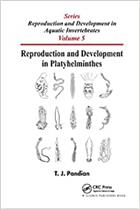Reproduction and Development in Platyhelminthes
- Series : Reproduction and Development in Aquatic Invertebrates
Volume: 5 - Publisher : Taylor & Francis Ltd
- Illustrations : 61 b/w illus
Our customers have not yet submitted a review for this title - click here to be the first to write a review
Description:
This book is a comprehensive elucidation on aspects of reproduction and development in platyhelminthes covering from acoelids to taeniids. With the unique presence of neoblasts, turbellarians serve as a model for studies on cancer and senescence. Of ~ 27,000 species, ~ 77% are parasites; they are harmful to man and his food basket from livestock and fish. The stress hormone, cortisol level is responsible for susceptibility and resistance of the host. In digeneans, the propagatory multiplication potency is retained by all the larval forms and in either direction in sporocyst. The higher clonal diversity, mixing and selection in Second Intermediate Host (SIH) may purge inbreeding depression suffered by the fluke on propagatory multiplication in First Intermediate Host (FIH). Of 12,012 digeneans, 88% may engage 33,014 potential SIH species. They have the choice to select one among the available/awaiting 3.5 host species. The motility of vertebrate host and euryxenic flexibility/scope for selection of SIH species has increased lineage diversification in digeneans. The life cycle of cestodes is divided into aquatic and terrestrial patterns. The former includes (i) oncosphere and (ii) coracidium types and the latter (iii) hexacanth-cysticercoid, (iv) hexacanth-tetrathyridium and (v) hexacanth-cysticercus types. The share for the oncosphere, coracidium and hexacanth types is 17.0, 29.5 and 46.5%, respectively. The staggering fecundity and adoption of the intermediate host in the herbivorous/insectivorous food chain have enriched Taenioidea as the most (2,264) speciose order. Sex specific genes Smed-dmd 1 and macbol have been identified, and neuropeptides and dipeptides are involved in sexualization. Trematodes are unable to parasitize elasmobranchs, as they cannot suck body fluid/blood containing a high level of urea. Relatively higher fecundity supplemented with propagatory multiplication, incorporation of SIH in 88% species, clonal selection in SIH, and euryxenic flexibility and the widest choice for selection of SIH have led to the highest lineage diversification to render digeneans as the most speciose order in Platyhelminthes.
Other titles from the series : Reproduction and Development in Aquatic Invertebrates
Click to view all titles in this series...
You may also like...
Jellyfish and Allies of the British and Irish Coast (Identification Chart)
Trehern, R.; Shields, C.
Price £4.00
North-West European Thecate Hydroids and their Medusae. Part 1 (Synopses of the
Cornelius, P.F.S.
Price £40.00
North-West European Thecate Hydroids and their Medusae. Part 2 (Synopses of the
Cornelius, P.F.S.
Price £40.00
British Freshwater Crustacea Malacostraca: a key with ecological notes
Gledhill, T.; Sutcliffe, D.W.; Williams, W.D.
Price £17.00














